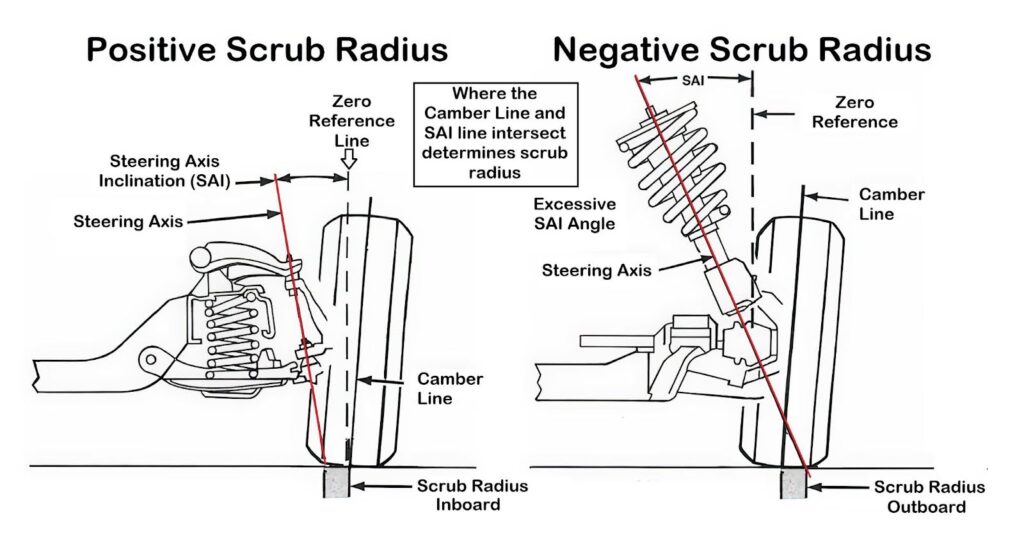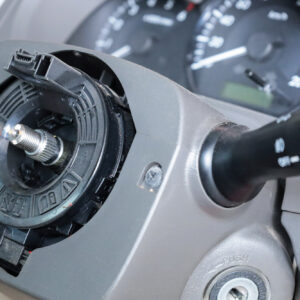When you turn your car’s steering wheel, it’s usually the front wheels that follow the motion. But have you ever wondered why the front wheels are usually the only ones to turn? Why do most vehicles have front-wheel steering, and what happens to those that utilize rear-wheel steering as well? Let’s find out.
Why Do Most Vehicles Use Front-Wheel Steering?
Front-wheel steering is the norm for a reason. Most vehicles these days utilize front-wheel steering alone to pilot the rest of the vehicle body. As for why front-wheel steering is more common than pure rear-wheel steering, it’s all down to physics.
Mechanical and Pneumatic Trails
To understand the effect that front-wheel steering has on your vehicle, it’s important to understand mechanical and pneumatic trails. To do that, you should know about the caster angle.
The caster angle is the angle between a steered wheel’s steering axis and an imaginary vertical line that crosses it when the wheel is viewed from the side. The imaginary line runs straight through the wheel’s center.
To find the mechanical trail, you’d need to find the distance between where the imaginary axis meets the road and the tire’s physical point of contact.

Positive Mechanical Trails
Most mechanical trails are positive and found in front of the tire. This helps the wheel self-right itself after a turn, keeping the vehicle moving in a straight line by essentially pulling the wheel.
When the caster angle (steering axis seen from the side) is set positive (tilted back at the top), turning the wheel actually raises the front of the vehicle very slightly so that the when the front of the vehicle is at its lowest point is when the wheel is centered. Thus, with proper caster angles, the steering wheel will naturally return to center due to gravity and the weight of the vehicle.
Longer positive mechanical trails make driving easier overall, but shorter trails are better if you want more control.
Negative Mechanical Trails
If the point where the steering axis and road meet is behind the tire’s contact patch, then that indicates a negative mechanical trail.
Negative mechanical trails don’t self-right the tires automatically. It’s also more difficult to drive vehicles with negative mechanical trails because they’re more susceptible to lateral movement and lack directional stability.
Pneumatic Trail
The pneumatic trail is related to the mechanical trail. It’s the trail created when the vehicle’s tires connect with the road surface. It’s usually behind the centerline and causes self-aligning torque along the wheel’s side.
As the wheel turns, the pneumatic trail can create a torque that turns the wheel away from the turn.
How Do Mechanical and Pneumatic Trails Affect Steering?
In front-wheel steering systems, the mechanical trail and pneumatic trail generally work together to help the vehicle align itself after a turn. The self-righting effect from the mechanical trail works in tandem with the pneumatic trail’s self-aligning torque, keeping the wheels balanced and in their intended positions.
On rear-wheel steering systems, these forces are more imbalanced. When steering with the rear wheels, the rear wheels face away from the desired direction. That means the torque from the pneumatic trail is pushing the wheel in the wrong direction and causing a more unstable driving experience overall if not handled properly.
Tire Preservation
On rear-wheel steering systems, the rear tires move against momentum rather than rolling with it, which can damage the tire faster over time.
Steering affects the steering tires. If you have a front-wheel steering system, the front wheels will wear faster than the back ones. It won’t be as bad as rear-wheel systems, but it’s enough that you should really swap your tires around halfway through their lifespan for better steering control.
Are There Rear-Wheel-Only Steering Vehicles?
Rear-wheel-only steering systems are rare and most aren’t found in passenger vehicles. Forklifts and other low-speed commercial vehicles sometimes use them though.
How Do Rear-Wheel Car Steering Systems Work?
Rear-wheel steering systems emerged in the 80s and 90s. They’ve recently become more popular in performance and luxury vehicles.
These systems move with the front-wheel steering system to allow the driver more control in tighter turns. Modern systems have a low-speed state (where the rear wheels turn in the opposite direction to the front wheels) and a high-speed state (where they turn in the same direction).
These rear-wheel steering systems are technically part of a four-wheel or all-wheel steering system because they work in tandem with a front-wheel steering system to control the vehicle.
What Are Four-Wheel Steering Vehicles?
As their name implies, four-wheel steering systems utilize all four wheels to steer the vehicle. Thanks to this synchronized control, four-wheel steer vehicles tend to have more maneuverability in different terrains.
These steering systems work using a mechanism that actuates the rear wheel angles based on how the front wheels turn and the vehicle’s speed.
Is Four-Wheel Steering Better Than Front-Wheel Steering?
Four-wheel steering has pros and cons compared to front-wheel steering.
Steering Response and Stability
Because all four wheels are working to steer the vehicle, all-wheel steering offers more precise control than front-wheel steering. This translates to better stability as well, which helps keep the vehicle from getting stuck.
Terrain Adaptability
Four-wheel steering’s added control and stability are great for different terrains like snow or ice, which helps prevent accidents.
Cost
Cost-wise, four-wheel steering is more pricey than front-wheel steering. It’s a feature for high-end vehicles at the moment because it requires more components and more precise steering calibration.
Repairs and maintenance are also more costly because they’re more complex. Tire changes will likely be more frequent as well given the strain from all-wheel steering.
Safety
Four-wheel steering can increase your vehicle’s safety and maneuverability, especially in more difficult or volatile driving conditions. It might just be worth the price tag if you often find yourself in these situations.
Modern steering systems for cars might be going back in time for some of their newer tricks, but that doesn’t mean those tricks are outdated. While four-wheel steering systems have been around for decades now, modern technology has made them much more stable and reliable overall.
Front-wheel steering remains the norm, but it might only be a matter of time before modern vehicles transition to all-wheel steering systems.
Any information provided on this Website is for informational purposes only and is not intended to replace consultation with a professional mechanic. The accuracy and timeliness of the information may change from the time of publication.




















